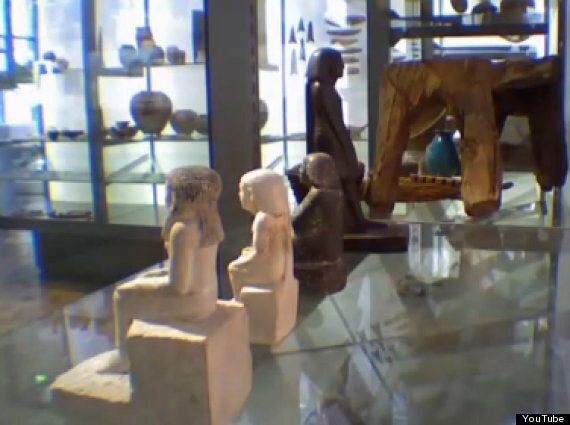Eerie footage had experts in a spin, but now the mystery surrounding a "possessed" ancient statue has been solved following a scientific investigation.
The 4,000-year-old Egyptian statue had curators at Manchester Museum puzzled after it began to mysteriously rotate in the night, despite being housed in a secure glass case.

The statue of Neb-Senu (dark stone) has been filmed spinning 180 degrees
Neb-Senu is a 10in (25cm) statuette made in about 1800 BC as a medium for the soul of an ancient Egyptian man.
Explanations for its movement ranged from mystical and magical ancient myths, curses and spirits to the object being possessed.
But, following an investigation, a far more 21st century reason has been unearthed - that the figure rotated as a result of vibrations from passing footfall and traffic.
ITV's Mystery Map, which investigates myths and mysterious stories, enlisted specialists to place sensors under the cabinet to detect vibrations, which dispelled some of the more outlandish claims.
Vibration expert Steve Gosling undertook a 24-hour test by placing a specialist three-axis sensor under the wall-mounted cabinet containing the relic, to record any vibrations present.
Beginning the test at 6pm, he found there was a peak in vibration level which correlated with movement at this time.
Overnight the vibrations stopped and the statue stopped rotating. Movement began again at 7am the following day - at the same time the vibrations also started again.
Mr Gosling said: "The vibration is a combination of multiple sources so there's buses outside on the busy road, there's footfall activity. And it's all of those things combined."
When asked why other displays were not rotating, he added: "This statue has a convex base. There's a lump at the bottom which makes it more susceptible to vibrations than the others which have a flat base. This is conclusive."
Anna Garnett, an Egyptology curator, previously attributed the mysterious movement to "a force beyond the physical" whilst Yulan Li, a student, ascribed the motion to magic.
Professor Brian Cox previously said he thought the movement was a result of friction between the carved serpentine figure and the glass shelf.